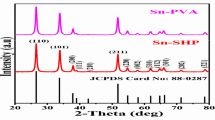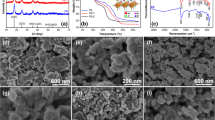Abstract
In this paper, we wish to present an overview of the research carried out in our laboratories with low-cost transition metal oxides (manganese dioxide, iron oxide and vanadium oxide) as active electrode materials for aqueous electrochemical supercapacitors. More specifically, the paper focuses on the approaches that have been used to increase the capacitance of the metal oxides and the cell voltage of the supercapacitor. It is shown that the cell voltage of an electrochemical supercapacitor can be increased significantly with the use of hybrid systems. The most relevant associations are Fe3O4 or activated carbon as the negative electrode and MnO2 as the positive. The cell voltage of the Fe3O4/MnO2 device is 1.8 V and this value was increased to 2.2 V by using activated carbon instead of Fe3O4. These two systems have shown superior behavior compared to a symmetric MnO2/MnO2 device which only works within a 1 V potential window in aqueous K2SO4. Furthermore, the activated carbon/MnO2 hybrid device exhibits a real power density of 605 W/kg (maximum power density =19.0 kW/kg) with an energy density of 17.3 Wh/kg. These values compete well with those of standard electrochemical double layer capacitors working in organic electrolytes.
Similar content being viewed by others
References
Conway BE (1999) Electrochemical Supercapacitors, Scientific Fundamentals and Technological Applications. Kluwer, Plenum, New York
Taberna PL, Simon P, Fauvarque JF (2003) J Electrochem Soc 150:A292
Toupin M, Bélanger D, Hill IR, Quinn D (2005) J Power Sources 140:203
Lust E, Janes A, Arulepp M (2004) J Electroanal Chem 562:33
Vix-Guterl C, Saadallah S, Jurewicz K, Frackowiak E, Redam M, Parmentier J, Patarin J, Béguin F (2004) Mater Sci Eng B 108:148
Rudge A, Davey J, Raistrick I, Gottesfeld S, Ferraris JP (1994) J Power Sources 47:89
Fusalba F, El Mehdi N, Breau L, Bélanger D (1999) Chem Mater 11:2743
Naudin E, Ho HA, Branchaud S, Breau L, Bélanger D (2002) J Phys Chem B 106:10585
Kim H, Popov BN (2002) J Power Sources 104:52
Chang K-H, Hu C-C (2004) J Electrochem Soc 151:A958
Soudan P, Gaudet J, Guay D, Bélanger D, Schulz R (2002) Chem Mater 14:1210
Lee HY, Goodenough JB (1999) J Solid State Chem 144:220
Lee HY, Manivannan V, Goodenough JB (1999) C R Acad Sci Paris 2(serie II c):565
Wu MS, Chiang PCJ (2004) Electrochem Solid-State Lett 7:A122
Pang SC, Anderson MA, Chapman TW (2000) J Electrochem Soc 147:444
Lee HY, Kim SW, Lee HY (2001) Electrochem Solid-State Lett 4:A19
Hu CC, Tsou TW (2002) Electrochem Commun 4:105
Chin SF, Pang SC, Anderson MA (2002) J Electrochem Soc 149:A379
Jiang J, Kucernak A (2002) Electrochim Acta 47:2381
Hu CC, Tsou TW (2002) Electrochim Acta 47:3523
Jeong YU, Manthiram A (2002) J Electrochem Soc 149:A1419
Broughton JN, Brett MJ (2002) Electrochem Solid-State Lett 5:A279
Hong MS, Lee SH, Kim SW (2002) Electrochem Solid-State Lett 5:A227
Toupin M, Brousse T, Bélanger D (2002) Chem Mater 14:3946
Kim H, Popov BN (2003) J Electrochem Soc 150:D56
Hu CC, Wang C-C (2003) J Electrochem Soc 150:A1079
Chang JK, Tsai WT (2003) J Electrochem Soc 150:A1333
Reddy RN, Reddy RG (2003) J Power Sources 124:330
Brousse T, Bélanger D (2003) Electrochem Solid-State Lett 6:A244
Brousse T, Toupin M, Bélanger D (2004) J Electrochem Soc 151:A614
Toupin M, Brousse T, Bélanger D (2004) Chem Mater 16:3184
Jones D, Wortham E, Rozière J, Favier F, Pascal JL, Monconduit L (2004) J Phys Chem Solids 65:235
Chen YS, Hu CC, Wu YT (2004) J Solid-State Electrochem 8:467
Zhou YK, He BL, Zhang FB, Li HL (2004) J Solid-State Electrochem 8:482
Reddy RN, Reddy RG (2004) J Power Sources 132:315
Chang JK, Chen YL, Tsai WT (2004) J Power Sources 135:344
Chang JK, Lin CT, Tsai WT (2004) Electrochemistry Commun 6:666
Wu M, Snook GA, Chen GZ, Fray DJ (2004) Electrochemistry Commun 6:499
Broughton JN, Brett MJ (2004) Electrochim Acta 49:4439
Raymundo-Pinero E, Khomenko V, Frackowiak E, Béguin F (2005) J Electrochem Soc 152:A229
Wu N-L, Wang S-Y, Han C-Y, Wu D-S, Shiue L-R (2003) J Power Sources 113:173
Wu NL (2002) Mater Chem Phys 75:6
Wang SY, Wu NL (2003) J Appl Electrochem 33:345
Cottineau T, Delahaye T, Brousse T, Bélanger D, in preparation
Prasad KR, Koga K, Miura N (2004) Chem Mater 16:1845
Prasad KR, Miura N (2004) Electrochemistry Commun 6:849
Lee HY, Goodenough JB (1999) J Solid-State Chem 148:81
Cottineau T, Brousse T, Bélanger D, in preparation
Pourbaix M, de Zoubov N (1963) Atlas d’équilibres électrochimiques. Gautier-Villars, Paris
Hong MS, Lee SH, Kim SW (2002) Electrochem Solid-State Lett 5:A227
Franger S, Bach S, Farcy J, Pereira-Ramos JP, Baffier N (2002) J Power Sources 109:262
Zhou ZH, Wang J, Liu X (2001) J Mater Chem 11:1704
Kudo T, Ikeda Y, Watanabe T (2002) Solid State Ionics 153:833
Villers D, Jobin D, Soucy C, Cossement D, Chahine R, Breau L, Bélanger D (2003) J Electrochem Soc 150:A747
Author information
Authors and Affiliations
Corresponding author
Additional information
PACS
82.47.Uv; 82.45.Fk; 82.45.Yz
Rights and permissions
About this article
Cite this article
Cottineau, T., Toupin, M., Delahaye, T. et al. Nanostructured transition metal oxides for aqueous hybrid electrochemical supercapacitors. Appl. Phys. A 82, 599–606 (2006). https://doi.org/10.1007/s00339-005-3401-3
Received:
Accepted:
Published:
Issue Date:
DOI: https://doi.org/10.1007/s00339-005-3401-3




